When someone utters the word ‘ninja,’ what you envision might differ greatly from the person next to you. You might conjure up images of a figure in black with a wakizashi at their side, making symbols with their hands and murmuring. Someone else might think of the video game or anime renditions.
Even in Japan, the history of ninja is shrouded in misconceptions and myth.
So, when the opportunity arose to experience an event called ‘The Ninja: Who Were They?’ at Odaiba’s Miraikan Museum (日本科学未来館), this enthusiast could barely contain her excitement.
Background Information – Before Miraikan Visit
Before visiting the Miraikan — formerly known as the National Museum of Emerging Science and Innovation — in Odaiba, I wanted to rehash my own knowledge of the ninja. After all, making comparisons to the research presented by Mie University, the Japan Ninja Council, the Iga Ueno Tourist Association, and Miraikan scientists is crucial to correcting preconceived notions of the ninja.
Here’s what I knew prior to visiting the Miraikan exhibition:
The Ninja
- Predominant in Japan’s feudal war period
- Primarily agents of espionage and stealth
- Every faction seemed to have at least one ninja working for them
- Used to either disrupt or distract or assassinate enemies
- Rumored to be a mix of aristocracy and commoners
- Male and female
The Art of Ninjutsu
- Two leading styles: Iga-ryu and Koga-ryu.
- Not a focus on physical strength
- Stealth; deception
- Intellectual solutions to combat
- Utilizes divination, psychological warfare and parapsychology. Poisons and other illusionary tactics were considered a ninja’s best weapons.
History of Ninja
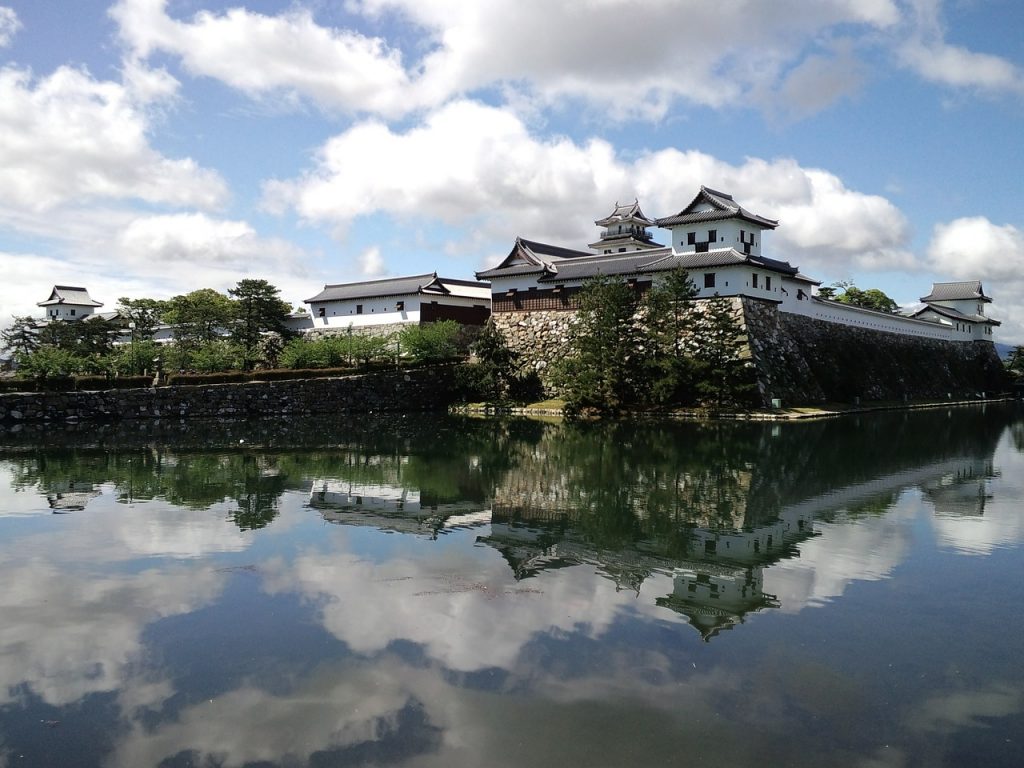

Japanese folklore states that shinobi are descendants of a demon that was half-man and half-crow (tengu). While awesome were it true, ninjutsu has actually been around for quite some time.
According to the Iga Ninja Association, ninjutsu was not a product of the Sengoku period but much earlier – 500 AD, in fact. It can be traced back to the Indian sub-continent, nearly to 4000 BC, when ancient Indian spirituality melded with Chinese martial arts. From there, the Japanese learned of it from communications with the Korean peninsula.
Prince Shotoku Taishi (574-622), the regent of Empress Suiko, the first female monarch of Japan, not only created the Seventeen-Article constitution, he was devoted to spreading Buddhism throughout the Japan and dispatched envoys to and from China. This places him in a time when primitive forms of ninjutsu were spreading throughout Asia.
In fact, it is rumored that he employed a man named Otomono Sahito, the “father of ninja.” A popular tale is that Shotoku Taishi could “hear the words of ten people at once.” This is in reference to the intelligence gathered by his shinobi spy.
Note: Read this for a comprehensive history of the ninja.
Tensho Iga-no-ran (Iga Rebellion of Tensho)
In the late 1500s, Iga became a warzone when Oda Nobunaga learned of his son, Nobukatsu, attacking the land. Iga was victorious then, because they knew their land and had superior firepower. Furious that his son was driven back, Oda Nobunaga launched an all-out assault in 1581. 50,000 soldiers, equal to half the population of Iga, invaded the territory. The Iga people endured the attack for about a month, yet the buildings and land were razed down, and many lost their lives.
The Tensho Iga-no-ran went down in history as a tragedy that served as a catalyst to ending the Iga ninja clan’s activities.
A lot of historical artifacts were destroyed at this time, but organizations like the Japan Ninja Association and Mie University spent years collecting old handbooks, scrolls and scientific data. Some pages of the Three Great Books of Ninjutsu — Mansen Shukai, Shoninki (detailing Kishu-ryu), and the Shinobi Hiden—were available for viewing at the Miraikan event. These texts were written during the Edo period and served to record oral traditions.
‘The Ninja: Who Were They?’ Exhibition
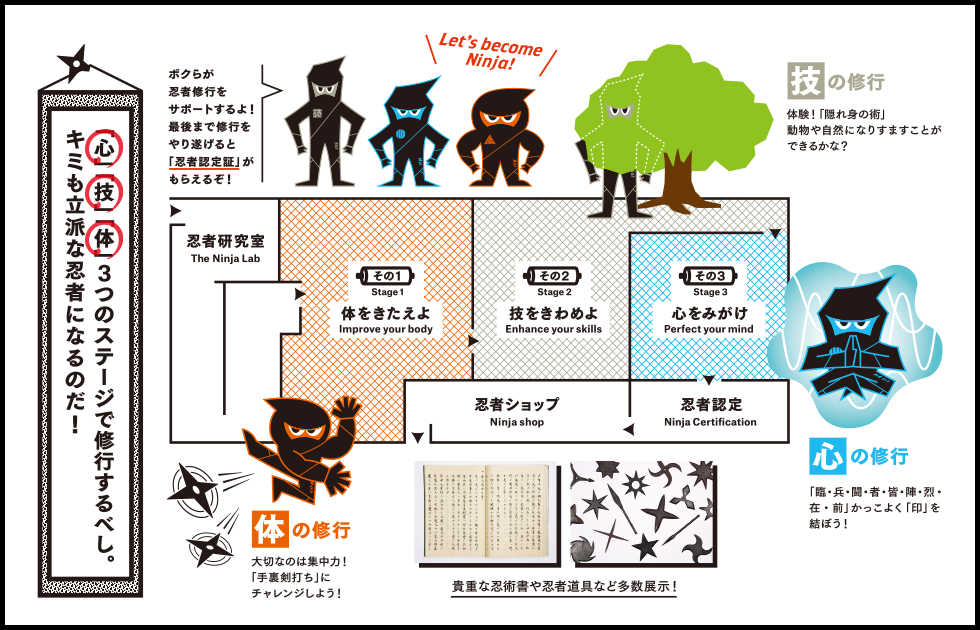

The event at the Miraikan was made a reality through the cooperation of several respected individuals in the field of ninjutsu and history. The two main names are Yuushi Yamada, a professor at Mie University who specialized in ninja research, and Ryuu Wada, the author of the high appraised book Shinobi’s Country.
Little was known about the exhibition before the opening day, but a diagram was shown on the main website featuring the areas you would be traveling through to learn about the ninja.
These were broken down into three “stages”:
- Improve your body
- Enhance your skills
- Perfect your mind
Once you’ve completed these areas, you would be rewarded with a certificate accredited by the Japan Ninja Council.
Sounds like a rigorous event, right?
In all honesty, dodging the screaming children that were running amuck and the hordes of other visitors was probably the real test of mental and physical fortitude! I never expected the event to attract so many kids. But when I got inside, it was clear what age group the hands-on experiences were aimed at — certainly not twenty-somethings.
The Ninja Lab – Miraikan Exhibition
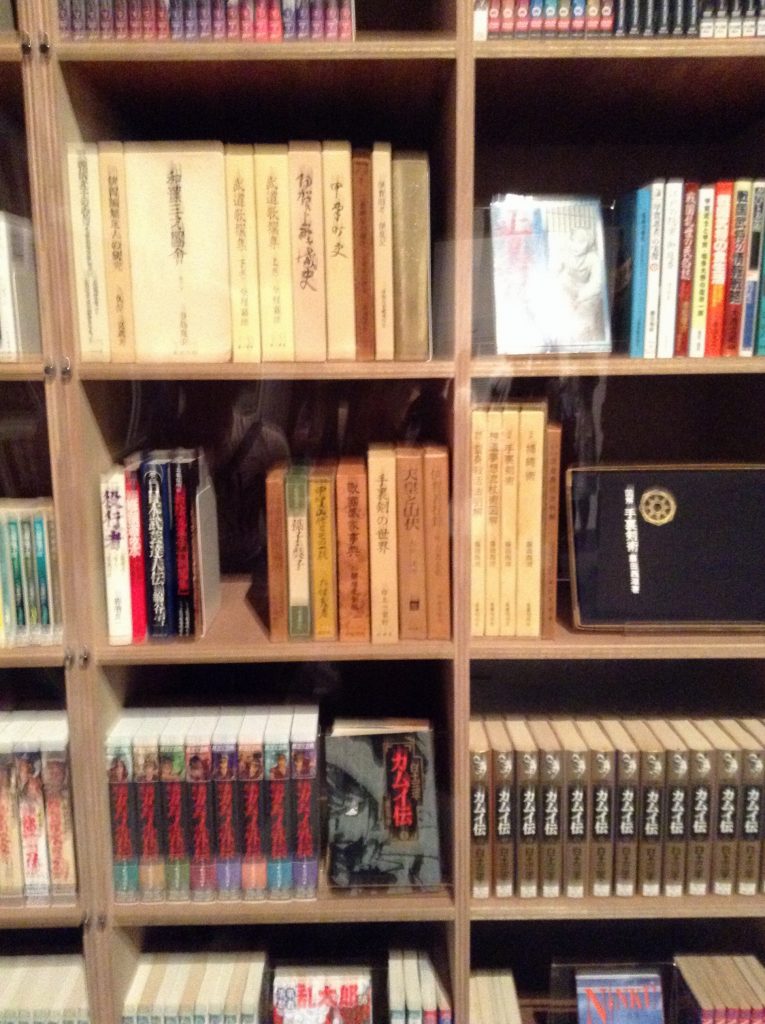

As soon as my time to enter the exhibition came, I was one of the first inside. A wall was set up and covered first with society’s notions of what ninja are and how they functioned. Once you pass a wall of movie posters and manga, you see a long display of the Three Great Books of Ninjutsu and other ninja “how-to” books.
Despite there being “no photography” signs in every case, I decided to use my surreptitious ninja skills and snap a few shots.
Most of the materials displayed are purely historical recounts of specific battles. The explanations of what’s described inside were brief and vague. Other articles pertained to being the best ninja you can be.
I’d been hoping for more historical insight on certain battles or some clarification on specific ninja movements, but there wasn’t much of that.
Stage 1: Improve Your Body

Rounding the corner, there was a short video clip featuring a holographic ninja master explaining how being a ninja requires great physical endurance and strength. When you pass this, you find yourself in a huge space filled with dozens of movement based games, several display cases, and hundreds upon hundreds of excited kids flinging plastic shuriken.
Principles of Ninja Movement
I found the Principles of Ninja Movement to be rather fascinating.
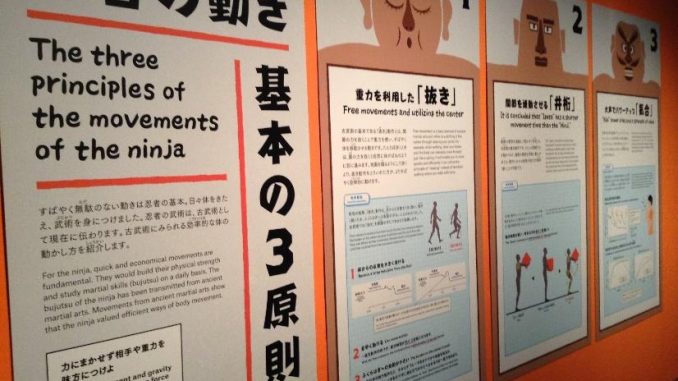
This wall talks about how the ninja were reliant on maintaining a crouched position for a couple of reasons.
- First, being closer to the ground allows you to move more reactively and stealthily, since your center of gravity is lower.
- By bending at the knees and maintaining a strong back, transporting heavy equipment is even simplified.
- Lastly, this position also effects the breathing.
Freer movement means you can focus purely on keeping an even breath and utilizing the diaphragm completely. When standing straight, people tend to breathe shallowly. Ninja, however, knew how to control their breaths. Considering how ninjutsu had influences from Indian culture and religion, I saw a connection to yoga pranayama, or breath work.
Shuriken Throwing and other “obstacles”
After this, you could participate in shuriken throwing, river crossing and hill climbing if desired. Sadly, the obstacles were made for toddlers, so I didn’t even attempt at wriggling through the holes or scaling the wooden “mountains”.
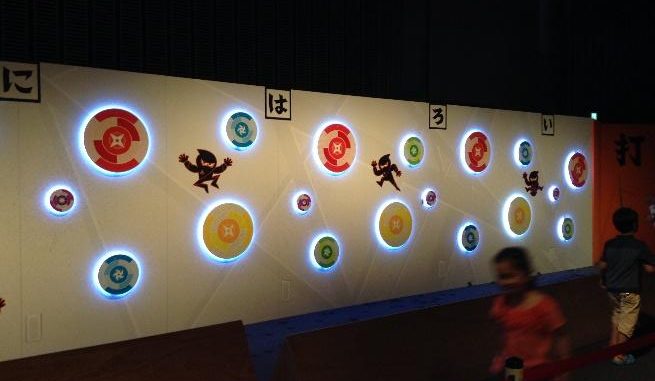
I headed for the middle of the first zone where cases of weapons and other ninja tools could be viewed. Again, there was that danged “no photography” sign and a security guard giving me suspicious glances. So, I couldn’t get any shots of the varieties of shuriken, blow darts, caltrops, spiked rings and knuckles, scythes and water floatation shoes.
The water floatation shoes were crafted of light wood and looked like a snowshoe. A ninja would either use them like an inner tube or stand on the floating platform as they traveled down the river.
Nutrition & herbs
Stage 1 even covered the diet and pharmaceuticals ninjas utilized to stay in shape and healthy while out in the field. Supposedly, ninjas relied on simple staples of the era: rice, miso, natto, vegetables. Some evidence even suggests that ninjas would eat locusts for protein.

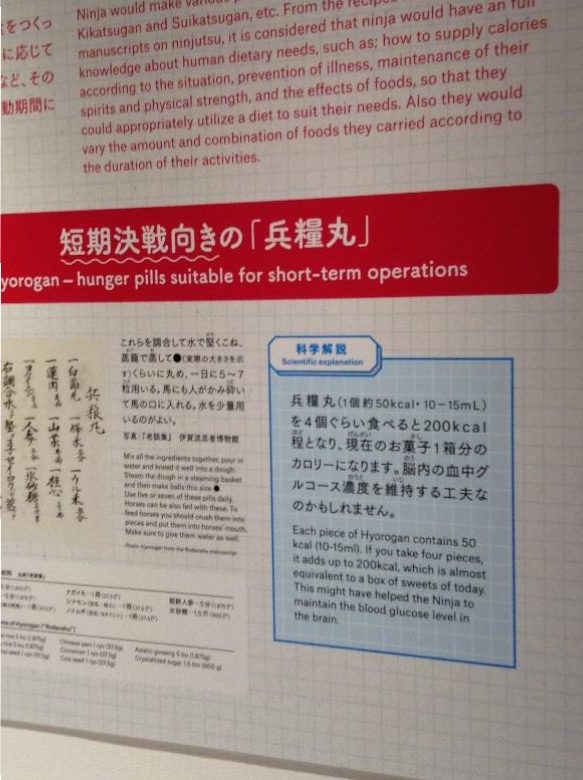
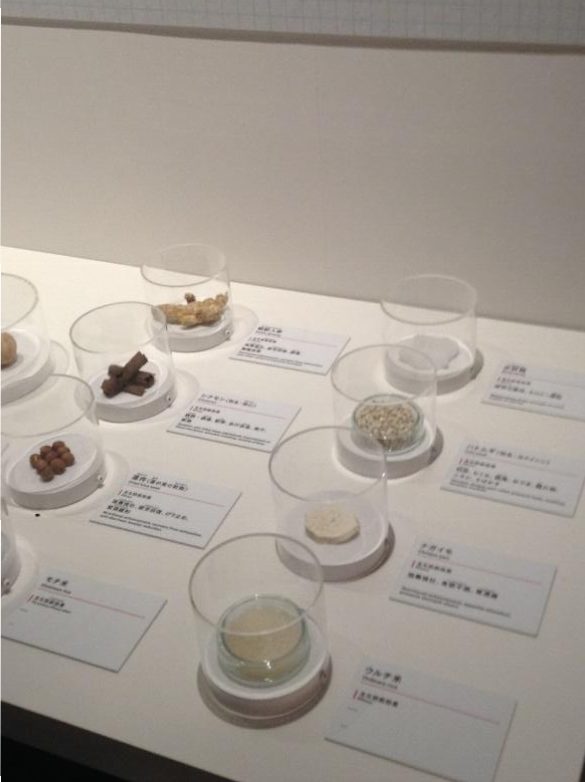
[Scientific Explanation]
Each piece of Hyorogan contains 50 kcal (10-15ml). If you take four pieces, it adds up to 200kcal, which is almost equivalent to a boc of sweets of today. This might have helped the Ninja to maintain the blood glucose level in the brain.
Isn’t it kind of crazy how ninjas are thought to only have consumed about 2000 – 2500 calories daily?
One wall explains how they could stave off hunger. In a few ninjutsu manuals there are instructions for making “Hyorogan”—hunger pills containing a things like ginseng, sugar, ginger, cinnamon, seeds and grits to keep their blood glucose from dropping.
Stage 2: Enhance Your Skills

At this point in your “training”, there are signs instructing you about your first mission.
You must build a signal fire at the end of the trail to lead your samurai daimyo home safely. Other ninja have passed through before you, leaving clues to enemy movements.
I’ll confess I was a bit disappointed. A lot of the information is solely visual. Young kids could pop in and out of “face-in-the-hole” displays and hide one foot high, two-dimensional bushes. I didn’t know those were even around until accidentally tripping over one when trying to avoid a runaway infant.
Still, the information is fascinating.
Hiding methods & signal fires

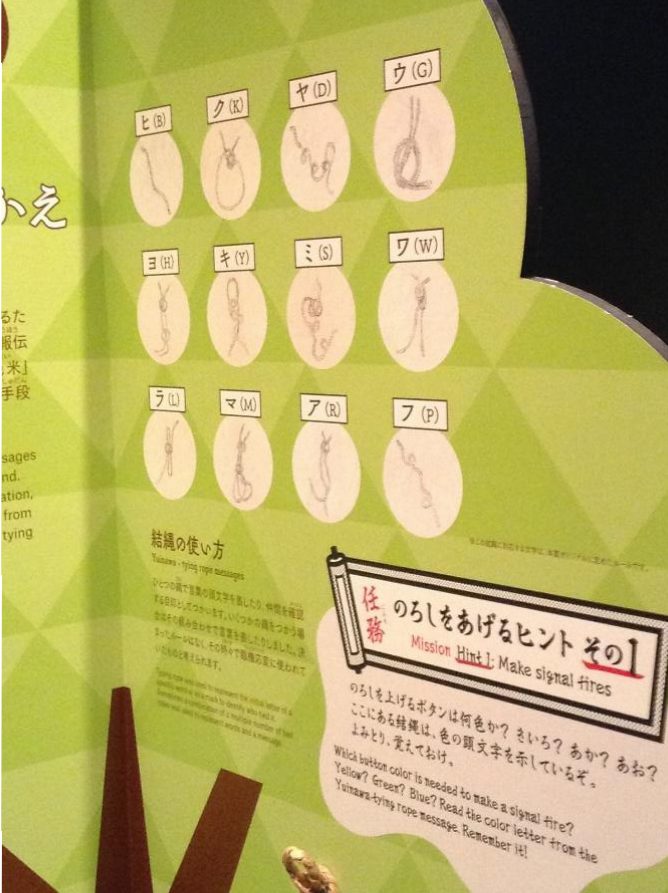
Hiding methods:
- Raccoon dog hiding; climbing up trees to hide
- Foliage hiding; hiding in bushes
- Quail hiding; wrapping yourself in a ball
- Fox hiding; hiding in the water
For example, when traversing the mountains, tracks would be covered by making use of the surroundings. Scaling trees to spy, moving through water and hiding in bushes seems to be activities modern media has gotten correct.
Ninja would also leave rope markers for allies that might be following. Only a trained eye would know where to look for these knotted messages. Depending on the knot, you could discern a meaning. For example, if a knot is tied in the “ki” shape and you know you need to create a certain colored fire, you will translate that as “light a yellow (ki) smoke signal.”
Eavesdropping using a cylinder
The next exercise helps us understand how ninja were able to eavesdrop through the floor using a hollow cylinder. By placing the cylinder on the floor or wall, it would pick up the vibrations coming through the opposite side.
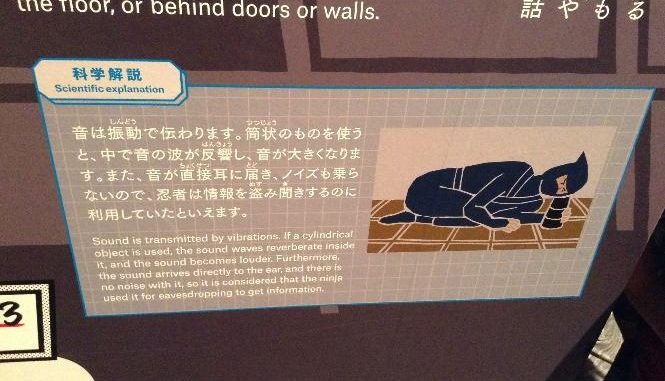
[Scientific explanation] Sound is transmitted by vibrations. If a cylindrical object is used, the sound waves reverberate inside it, and the sound becomes louder. Further, the sound arrives directly to the ear, and thee is no noise with it, so it is considered that the ninja used it for eavesdropping to get information.
Moving on, you could either wait in line for thirty minutes to play shadow puppets in front of an animated waterfall or skip that and move straight into practicing meditation techniques in Stage 3.
Stage 3: Perfect Your Mind

The shortest of the training levels in the exhibition, this involves making figures with both hands that have words attached to them (kuji in). This process has a calming effect on the mind when paired with rhythmic breathing. Ninja would meditate for brief periods before fulfilling their assignments.

Now, when I did another ninja experience in Asakusa’s Hanayashiki amusement park, I did not make the actual figures but instead firmly stated the meditative words while drawing perpendicular lines in the air.
At the Miraikan event, you try to follow a short video demonstration that plays on repeat. The movements are harder than they look!
Once you’ve managed to free your fingers from the pretzel knots, you are cleared to receive your certification.
Ninja Certification
There’s no grand ceremony or presentation. Anti-climatically, you approach a table with slots and a sign that says, “please only take one”. My friend who had joined me for the event gave me an incredulous look, stuck his hand in, and pulled out a paper card. He drew black. Mine came out blue.
“That’s it?” he asked.
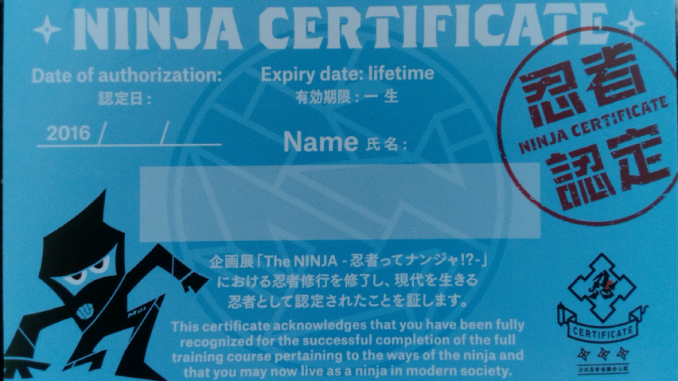
I nodded then listened to the recorded announcement emanating from a cardboard ninja cut-out: “Once you exit into the shop, you cannot reenter the exhibition.”
Final Thoughts
First, were my expectations met?
No. When you read the mission statement behind the exhibition about clarifying the misconceptions about ninja, one would assume the presence of ninja experts, live demonstrations of how tools were used, and more in-depth historical evidence provided. ‘The Ninja: Who Were They?’ exhibition at the Miraikan does not exactly clear the smoke and mirrors surrounding ninja.
Scientific explanations – yes; Historical information – lacking
A great amount of insight was provided on the weaponry, poisons and medications ninjas utilized. Yet, there was no mention about famous ninjas like Hattori Hanzo or Goemon. I can’t even recall one instance of kunoichi (female ninja) being explained.
Another thing, I had hoped to learn what kind of people made up the ranks of ninja. There is much uncertainty about whether or not ninja could be low born men and women, but I found nothing regarding that.

Second, the games are fun for children but not at all educational for those seeking historical research material. Part of me believes some information was not included to coax the curious into purchasing the books that the exhibition was based on.
Reconciling history with modern application
Nonetheless, the Miraikan Ninja exhibition is enlightening when it comes to how the ninja lived. I never knew that these warriors and spies were so fixated on mind and body wellness.
As it says on the back of the certificate, to be a ninja in modern society you need to be active in these three things:
- Improve your body, skill and mind and maintain a good balance.
- Take an active role in supporting the community you belong to.
- Find a mission for yourself and live through anything to the bitter end.
To me, that is an invaluable lesson to walk away from the event with.
Getting to the Miraikan
National Museum of Emerging Science and Innovation (Miraikan)
Japan, 〒135-0064 Tokyo, 江東区Aomi, 2−3−6
Note: The NINJA – who were they? is a special exhibition at the Miraikan that begins in 2 July and ends in 10 October 2016.

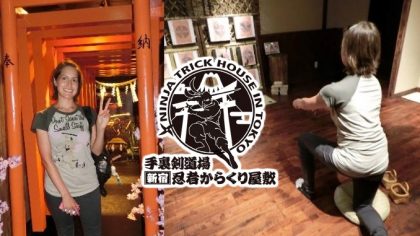
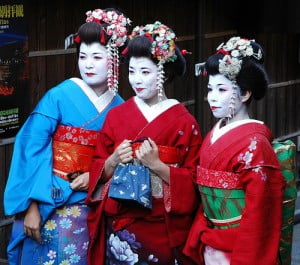
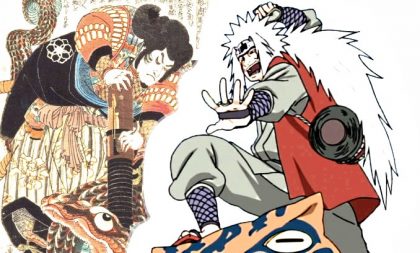
![Karate Training in Okinawa, Japan – Jesse Enkamp [Interview]](https://www.wayofninja.com/wp-content/uploads/2017/10/Jesse-Enakamp-420x211.jpg)
